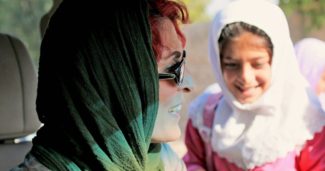3 Faces (Jafar Panahi, 2018): Iran
Reviewed by Bethany Burns. Viewed at AFI Fest 2018.
 3 Faces, (2018) a film by award winning Iranian New Wave film maker Jafar Panahi (The White Balloon 1995, The Circle 2000) is a story reflecting the microcosm of injustice and persecution many Iranian girls and women face throughout their lives. 3 Faces also won Best Screenplay at the Cannes Film Festival 2018, Best Film at Antalya Golden Orange Fest 2018, the Douglas Kirk Award at Hamburg Fest 2018. His films The Circle (2000) and Crimson Gold (2003) have been banned in his own country. He currently resides in Iran under house arrest after the Iranian government arrested and banned him from producing films. His love for his country and commitment to social change his main reason for not fleeing the country when given the chance. While waiting the appeal of his arrest he created the documentary This Is Not a Film (2011) and had is smuggled out the country inside a cake so that it could make its premier at the Berlin International Film Festival. Panahi is a stunning example of how breaking the rules can bring not only success but due attention to an unfair political system and forms of religious oppression.
3 Faces, (2018) a film by award winning Iranian New Wave film maker Jafar Panahi (The White Balloon 1995, The Circle 2000) is a story reflecting the microcosm of injustice and persecution many Iranian girls and women face throughout their lives. 3 Faces also won Best Screenplay at the Cannes Film Festival 2018, Best Film at Antalya Golden Orange Fest 2018, the Douglas Kirk Award at Hamburg Fest 2018. His films The Circle (2000) and Crimson Gold (2003) have been banned in his own country. He currently resides in Iran under house arrest after the Iranian government arrested and banned him from producing films. His love for his country and commitment to social change his main reason for not fleeing the country when given the chance. While waiting the appeal of his arrest he created the documentary This Is Not a Film (2011) and had is smuggled out the country inside a cake so that it could make its premier at the Berlin International Film Festival. Panahi is a stunning example of how breaking the rules can bring not only success but due attention to an unfair political system and forms of religious oppression.
I viewed this film at the AFI Film Festival in Los Angeles, 2018. I knew little about Panahi when I entered the theater and as the film was introduced it made my heart smile to learn of his plight as a film maker and his dedication to both his country and his craft. Since I was unsure of what to expect I embraced this film with an open mind and was not disappointed in the least bit. Panahi and actress Behnaz Jafari both play themselves in the film which from the very beginning drew me into the plight that was to unfold.
The opening scene of this film immediately plunges the viewer into the depths of the despair of a young Iranian girl named Marziyeh Rezaei. Marziyeh is desperate for help as she lives in a remote mountain village and desires to escape. In her desperation she records a cell phone video of herself committing a fake suicide and sends it to Panahi in an attempt to reach Jafari. This cry for help works and Jafari and Panahi embark on a journey to the young girl’s village to find out if the suicide was in fact real.
As the story unfolds an erratic and manic Jafari finds herself slowly calmed by the supportive insistence and calm demeanor of Panahi. As his relationships develop with each of the main female characters in the film he remains a subtle force of emotional and physical support for these women who are struggling. From the very beginning of the film while he calms the angry director of the film Jafari walked out on as well as his worried mother, Panahi maintains a balanced energetic resonance. I found this to be of paramount importance to the message he was trying to relay throughout this film. This subtle message of support for women revealed so much about Panahi and his commitment to the evolution of his countries treatment of women.
A mostly diegetic soundscape keep the viewer present within the stunning visual landscape in which the film in shot. Jafari and Panahi spend a great deal of this film inside a car and the cameras perspective is also shot from inside the car even when the characters have left it. I felt that this maintained the feeling of seclusion these two felt from the world around them especially within the remote mountain town to which they were traveling. Maximum depth of field was also utilized throughout the film to pull focus to small but important moments. Splashes of color within an otherwise mostly tan and monotone environment also added hints of vibrancy to the film. A blue door in the middle of a tan wall, or a pink scarf amidst an otherwise black and tan costuming drew focus to key elements of character development. Though the two lead characters were in fact playing themselves within the film their commitment to the narrative was stunning and allowed for the remainder to of the cast to also commit to their characters. For me committing to the character is paramount for the success of any sort of formal narrative film.
Within a world so bound by archaic and religious modalities of law I appreciate deeply film makers such as Panahi for remaining steadfast in their beliefs and committed to their cause.
About this entry
You’re currently reading “3 Faces (Jafar Panahi, 2018): Iran,” an entry on Student Film Reviews
- Published:
- 11.16.18 / 5pm
- Category:
- AFI Filmfest 2018, Films
4 Comments
Jump to comment form | comments rss [?]